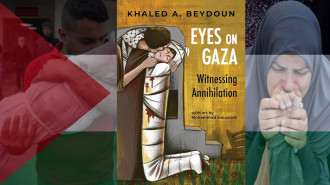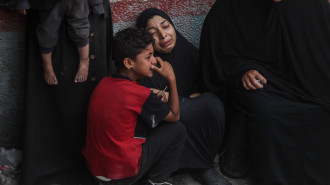
The untold stories of Gazan artists reshaping their artistic vision amid Israel's war

Access to art education in the Gaza Strip was limited until the mid-1990s when Al-Aqsa University began offering art courses.
Despite this late start, Gaza quickly developed a lively arts scene that drew in many artists from different backgrounds.
In 2002, seven artists came together to create Eltiqa Group for Contemporary Art, the first contemporary art space in Gaza. The goal was to help young artists by providing mentorship and free studio spaces, creating a supportive community.
However, artists in Gaza had very limited chances to share their work in the West Bank, making it hard for them to get noticed and opportunities became even more restricted when the blockade began making it difficult to find art supplies.
This situation forced artists to get creative and find new ways to make art.
Fast forward to 2009, another group of artists opened Shababeek, a space dedicated to visual arts, to help strengthen the art community further. Together with Eltiqa and Al-Aqsa University, Shababeek became a key place for artists to connect and create.
Sadly, since the onset of Israel's war on Gaza last year, all three of these important cultural spaces have been damaged or destroyed as the conflict continues.
One year on, The New Arab spoke with three artists who have been active in Gaza’s art scene to share their experiences during these difficult times and their hopes for the future of art in the region.
Samaa Abu Allaban
Samaa Abu Allaban is a visual artist living in Gaza. She has a degree in Graphic Design and uses tools like animation and digital art to express herself. For years, Samaa's work has focused on identity and humanity, sharing stories through oral history.
Samaa has exhibited her art in international shows, such as the Institut Français in Gaza and the APOLIDIÀ exhibition in Mestre, Italy. In addition to her exhibitions, Samaa illustrates children’s books, blending her artistic style with meaningful stories to inspire young readers.
For the past year, the ongoing attacks in Gaza have made it difficult for Samaa to create new work. “There is no room to think, let alone create, in these times,” she says, reflecting on the challenges she faces.
Frequent mass displacement in Gaza adds to these challenges. “I’ve moved from place to place and constantly fear for our safety,” she shares.
Like the well-known Palestinian artist Malak Mattar, Samaa’s recent art creations reflect the daily struggles of life in Gaza. She explains, “I have drawn many things about displacement and what is happening these days.”
To adapt to the scarcity of materials, Samaa collects resources from her surroundings, using cardboard, paper, and plastic in her art.
This can be seen in her latest project, The Genocide Kitchen, which explores food and cooking during wartime and highlights the harsh reality of Palestinians facing hunger and malnutrition.
The project not only captures the act of cooking during times of genocide and siege through a series of collages but also illustrates the strength of the Palestinian community.
Through its simple and quiet message, Samaa notes that The Genocide Kitchen reminds us of freedom and life — something that has been taken away from the Gaza Strip for years.
Samaa points out that she started The Genocide Kitchen with the sentence: “These are recipes you’ll never use,” emphasising how cooking as a daily activity differs from cooking amidst genocide and forced starvation.
She adds that despite the occupation, people are growing simple vegetables at home to cope with food shortages, stating, “Occupation cuts all the arteries of life in Gaza, but we always find a way to survive.”
Currently, Samaa uses an iPad to create her collages, combining photos of different elements with digital editing. Drawing inspiration from local artists like Mohammad Juha and Hazem Harb, she focuses on collage as a way to explore the beauty and strength found in everyday materials that we tend to take for granted.
Reflecting on her artistic journey so far, Samaa believes that art and life experiences are connected. “Art has been my passion since I was a child,” she shares. “I think artists can share their feelings with the world through their work.”
Rawan Murad
Rawan Murad, 26, currently lives in Khan Younis and has moved 11 times because of the war. She graduated in 2021 with a degree in Psychology and started drawing during her university years, encouraged by her younger sister.
Rawan has participated in several workshops, including the Future Cloud group of artists in the Gaza Strip, the Shattering project, the Finishing Occupation workshop, and the OFA mosaic project.
Additionally, Rawan's exhibitions include the Point of Gathering exhibition in 2022, the Piece exhibition in 2023, the Shattered City exhibition in 2023, and the Cloud exhibition at the Arab World Institute in France.
Like Samaa, Israel's ongoing war has completely transformed Rawan's artistic vision.
“The attacks have affected my ability to draw a lot,” Rawan shares with The New Arab. “I stopped completely in the early months. Nothing mattered after death. I felt shocked and lost the meaning of life. How could I translate all these massacres into art?”
Rawan added, “We’ve been constantly evacuating, fleeing from death. Our goal was just to stay alive. I struggled to find a quiet place to draw. I also don’t have the necessary tools anymore. Most of them have been destroyed.”
At present, Rawan is trying to regain her artistic voice by focusing on the present situation. “I am trying to keep my artwork away from the violent scenes of war,” she states.
Before the war, Rawan dreamed of creating beautiful paintings and sharing her work worldwide. “Now, I just want to live in a home safely. I’m no longer interested in success. I just want peace!” she expresses, feeling uncertain about her future.
“Every minute of my life feels threatened. I can’t see the future right now,” Rawan adds.
Amal Al Nakhala
Amal Al Nakhala, 25, lived in Gaza and studied English literature, but her true passion is art. She has been displaced seven times, fleeing her home in October and moving between Khan Younis and Rafah before finally escaping to Egypt in February.
To date, Amal has taken part in various local and international exhibitions and has created several animation films and comic books. She believes, “Art is freedom, and freedom is art.”
Amal also believes that art is personal and reflects one’s truth.
Since the war began, Amal’s art has become a diary that captures her experiences of displacement and her struggle to cope. “My art shows what is really going on in my head,” she explains. “I find motivation in myself and my surroundings. What’s happening isn’t easy to explain, and drawing helps ease my pain.”
Amal likes to use symbols in her art, creating pieces with deep meanings. One of her recent works called A Portrait of a Martyred Mother and Her Fetus, reflects the pain of Palestinians losing their loved ones.
“Sometimes, it is hard for civilians to identify their martyred loved ones. They might rely on small or fragmented pieces from the body, like teeth or fingers, or anything distinguishable,” Amal explained about her artwork.
As of March 14, reports indicate that 45 writers and artists in Gaza have been killed since October 7.
Undoubtedly, this number has increased since then and will continue to rise amid Israel's relentless bombardment.
Eman Alhaj Ali is a Gazan-based journalist, writer, and translator from the Al-Maghazi Refugee Camp
Follow her on X: @EmanAlhajAli1









 Follow the Middle East's top stories in English at The New Arab on Google News
Follow the Middle East's top stories in English at The New Arab on Google News


